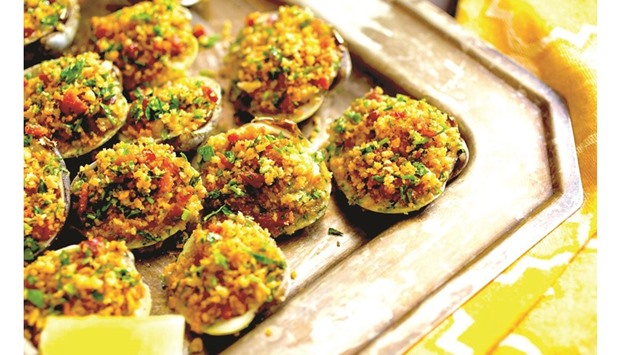I have noticed people now spend time and effort in making their dishes special and want their dishes to standout when it comes to social gatherings. One such dish which is simple yet very exotic is clam shells. Seafood is always associated with luxury and delicacy, whether it is a fresh fish catch of the day or shrimps, lobsters and salmon. In today’s write-up I’ll talk about clams, which are often found in luxury high end food establishments and hotels and are always a delight once prepared properly.
Clam is a common name for several species of bivalve mollusks. Many types of clams have been used for culinary purposes. The classic clam shell is shaped with ridges or concentric rings. They also come in many colours, and sizes. The difference between clams, mussels and oysters lie mostly in the shape of their shells. The word clam is used to denote those mollusks who spend most of their lives partially buried in the sand of the ocean floor. Unlike mussels and oysters, clams do not attach themselves to a hard surface but burrow into the sea bed sand. They obtain their food and oxygen through a syphon, which is a tube like structure which helps them breathe under water.
Mussel shells are slipper shaped and dark coloured and they cling in large numbers to rocks and they can be steamed or boiled for cooking. Oysters also cling to surfaces, but their shells are rougher and more irregular in shape than those of clams or mussels.
There are two divisions for clams – hard shell clams and soft shell clams. The term “soft shell clam” is a bit of a misnomer, as the shells of the clams are merely brittle and thin, rather than soft. Often, the clam cannot retract its neck all the way, meaning that a small portion of the clam sticks outside the shell at all times. Examples of soft shell clams include geoducks, razors, and steamers. Hard shell clams have a more typically solid shell, and they are able to retract their bodies all the way into the shell. Some common hard shell clams include chowders, littlenecks, and butter.
Interesting fact about clams –you can pick freshwater clams to live inside your aquarium. Another fact is that clams are classified under the herbivorous category of animals and they mainly eat plankton. Giant clams are considered a delicacy in Japan, where they love their giant clams. A giant clam can weigh up to 400 lb and can live up to 150 years. Clams do not have eyes, ears or nose.
Classic Clam Shells
Ingredients
Hard shell clams 12 nos
Unsalted butter 2 tbsp
Bell peppers, chopped 1/2 cup
Shallots, chopped 4 tbsp
Breadcrumbs 4 tbsp
Parmesan cheese, grated 1/4 cup
Flat leaf parsley 1/4 cup
Black pepper to taste
Garnish
Capellini roe to garnish
Lemon wedges 8-10 nos
Method
Arrange the clams on a thick baking tray and place in a preheated oven with steam.
Broil until the clams open, 5 to 7 minutes, once the clam shell opens remove and keep them aside.
Collect any clam juice from the baking tray and keep aside.
Remove the top shell of the clam and loosen the clam meat with a spoon but keep it connected to the shell corner.
In a heavy bottom skillet heat unsalted butter over high heat and add shallots till they turn translucent, followed by bell peppers.
Cook while stirring until the bell peppers are softened, add some moisture and few drops of lemon juice and reduce the liquid by half.
Remove from heat and stir in breadcrumbs, parmesan cheese and crushed pepper and chopped parsley leaves.
Spoon some breadcrumb mixture on each clam and broil them in oven until the topping is light golden brown in colour.
Remove from oven and serve hot garnished with capellini roe and lemon wedges on the side.
Note: Do not season with salt, as clams are already salty to taste. There are three sizes of clams – chowder clams, are the largest, followed by cherrystones and the littlenecks are the smallest. I prefer the cherrystones as they are small enough to eat whole in a bite yet big enough for a decent sized portion.
* Chef Tarun Kapoor,
Culinary Mastermind, USA. He may be contacted at [email protected]



